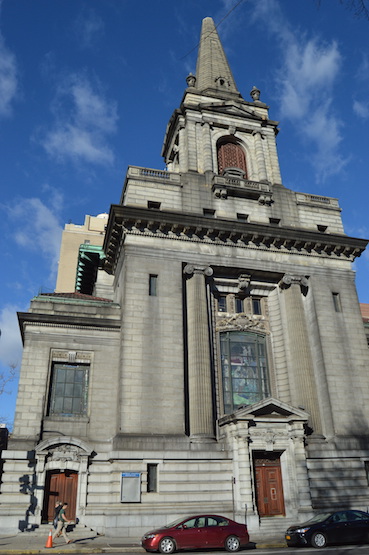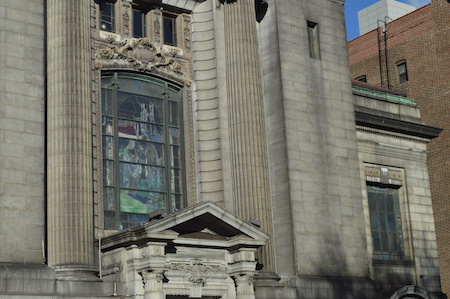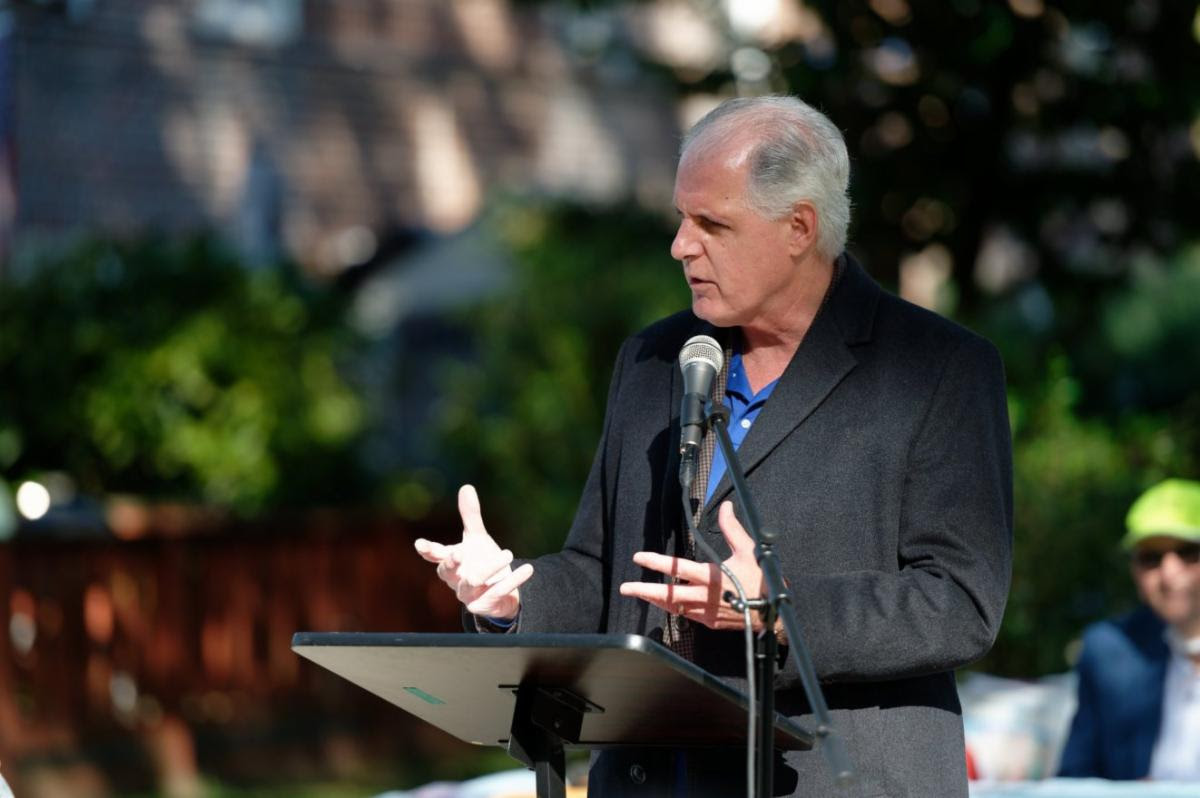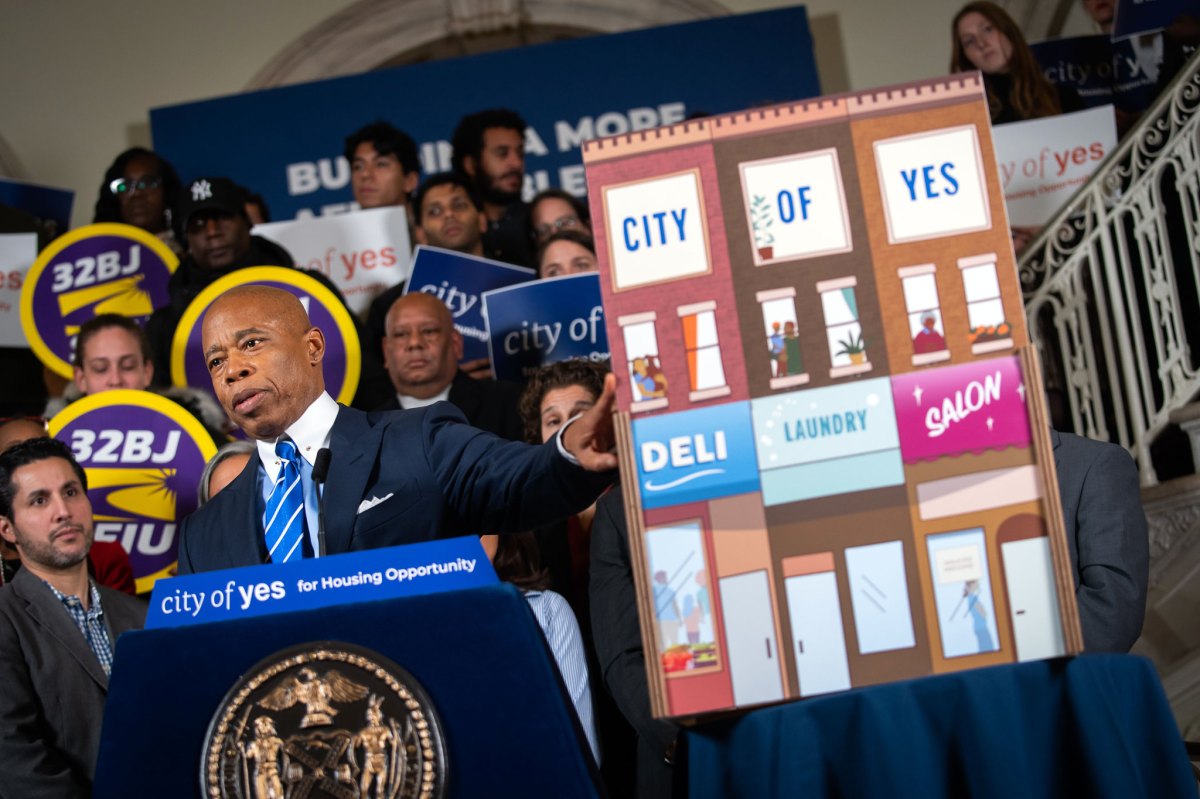
BY JACKSON CHEN | Local community members rejoiced as the city Board of Standards and Appeals, on June 2, rejected an application to convert the former First Church of Christ, Scientist building at 361 Central Park West into residential use.
Since the church, located across the street from the park at 96th Street, is a landmarked building, the project’s owners, developers Ira Shapiro and Joseph Brunner, were required to seek variances from the BSA in order to move forward with converting its interior into 34 residential units (down from 39 originally proposed), with some modifications to the exterior, as well.
The application had been tied up with the BSA since it first went before the board in September 2015, according to city records. At a March 8 meeting, the BSA refused to allow Shapiro and Brunner to withdraw their application in the face of an expected negative result, despite the developers’ assertion they were considering other possible uses for the building. They were, however, given another chance to return to the board to make their case, based on an expectation that some new information about the project might come to light.
During the June 2 meeting, however, the BSA remained critical, voicing dissatisfaction with the application as presented. The board was particularly wary of new financial projections that included different development cost estimates, projected condo sale prices, and construction financing interest rates.
After hearing some public testimony, mostly about the building’s use, a majority of the board voted to reject the project, which would have involved altering existing stained glass windows and adding a rooftop penthouse to the 1903 structure.
Despite the developers’ representatives requesting a chance to respond in writing to the community and the board’s concerns, the BSA took the position that the applicants had taken more than enough time to get the application right.
“We are profoundly disappointed in the decision,” said Mitchell Korbey, an attorney and urban planner representing Brunner. “The addition of 34 units was a minimal variance.”
Korbey added, “We’re examining all of our options, including a number of as-of-right opportunities that don’t require zoning variances.”
When asked to elaborate on those options, he responded that it was too early to say. The developers have for some time argued that maintaining the property as a landmark without redeveloping it imposes financial burdens on them.

“The Board of Standards and Appeals did the right thing today by denying the variance,” Michael Hiller, an attorney representing the opposition group, the Central Park West Neighbors Association, said right after the decision. “I feel like it was the only reasonable outcome based upon the application as filed and the law that governs the board’s deliberations.”
According to Hiller, the BSA’s decision represented an important win for landmarked buildings throughout the city. The developers’ claim of hardship, based on the building’s landmark status compromising its economic viability, he said, would set a dangerous precedent for other landmarks if approved.
Susan Simon, the founder of the Central Park West Neighbors Association, agreed, saying that if the First Church redesign went through, like-minded developers would routinely target landmarks as real estate possibilities.
“If they succeeded with the hardship call, that would have set a precedent throughout the city on landmark properties,” she said. “Everyone would buy a landmark property and then claim afterwards it was a hardship [in order] to develop it into luxury condos.”
Hiller said that the applicants’ arguments for a variance based on the church being obsolete and unusable were untrue because there were two organizations interested in the space.
One of the groups, the Fresh Start New Beginning Christian Church, led by its pastor, Terry Starks, expressed interest in returning the space to its original use as a church.
“Ain’t nothing wrong with that church,” Starks said. “We just need the doors to be open again and let the community back in.”
Starks, who previously was pastor for the Crenshaw Christian Center East that occupied the building until its sale in 2014, said his new congregation’s services would bring the building back to full capacity within a couple of years.
“I’m asking you to give me an opportunity to restore that church back to its community,” Starks pleaded with the BSA during the hearing. “We’re talking about thousands of lives that are going to be changed.”
Just before the BSA’s decision, Korbey said he would reach out to Starks about his congregation using the building, but Starks told Manhattan Express he had yet to hear from the owners. Korbey later said he wasn’t aware of whether the dialogue between the developers and Starks had occurred.
Starks said he’s interested in purchasing the church or in any alternative options for getting use of the building.
“The greatest thing in the world is for Fresh Start New Beginning to be in that building,” Starks said. “We’re the right fit for the church.”
Another organization that had previously voiced interest in the property, the Children’s Museum of Manhattan, told Manhattan Express earlier this year that its talks with the developers broke down over “an economic issue in terms of the proposed purchase price.”
Even if the building’s future is uncertain, opponents of the residential conversion are celebrating the BSA’s action.
“Given the political environment where developers have been bringing pressure to obtain approvals that are not warranted or justified,” Hiller said, “I commend the Board of Standards and Appeals for resisting any kind of pressure that may have been brought.”
Preservationists will undoubtedly keep a close eye on any new proposals for the property. According to Kate Wood, president of Landmark West!, the ball is in the developers’ court as they still have options for developing it within existing zoning regulations.
According to Wood, there are other groups and developers who potentially could put the building to more appropriate use without imperiling the property’s landmark values.
“Landmarks are used for their original purpose or adaptively reused for new purposes all the time,” Wood said. “This one is an extraordinary building and it cries out for an appropriate use.”
She added, “The thing about landmarks is it’s never over. Landmarks like the First Church will always need community vigilance.”






































